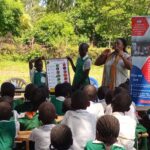
Day of the Girl Child: In Pursuit of Gender Equal World!
The International Day of the Girl Child is celebrated annually on 11th October and focuses attention on the need to address the challenges girls’ face and which impede their wellbeing and achievement of quality of life.
It also seeks to promote girls’ empowerment and the fulfilment of their human rights.
International Day of the Girl Child 2021
This year’s theme, ‘Digital generation. Our generation’ recognizes the profound transformations that have taken place in the last year as many countries turned towards high-tech education to ensure continuity of learning during the COVID-19 pandemic.
What this means for girls, who due to the gender digital divide are more likely than boys to be missing out on precious learning opportunities.
Putting young people front and center, the International Day of the Girl Child theme explores how to close gendered digital access and skills gaps, support safe online spaces, and leverage the power of technology to advance education.
Also, it seeks to address adolescent girls’ and women’s leadership and gender equality to ensure that girls are empowered to maximize their potential both online and offline.
According to UNESCO, girls have the right to a safe, educated, and healthy life, not only during these critical formative years, but also as they mature into women.
If effectively supported during the adolescent years, girls have the potential to change the world both as the empowered girls of today and as tomorrow’s workers, mothers, entrepreneurs and political leaders.
While the pandemic has accelerated digital platforms for learning, earning and connectivity, about 2.2 billion people below the age of 25 still do not have internet access at home.
The gender gap for global internet users grew from 11 per cent in 2013 to 17 per cent in 2019.
In the world’s least developed countries, it hovers around 43 per cent. In all regions in the world, more men than women are using internet: the gap is smaller in developed countries and larger in developing countries.
Girls are also less likely than boys to use and own devices, and gain access to tech-related skills and jobs.
Only by addressing the inequity and exclusion that span geographies and generations can we usher in a digital revolution for all, with all.
Girls face multiple challenges purely because of their age and gender. In many of the world’s poorest places, the odds are stacked against them when factors like ethnicity and disability heighten the existing disadvantages that they face.
From being denied an education to being forced into early marriages and female genital mutilation, girls face a myriad of obstacles that prevent them from realizing their full potential.
Ensuring the attainment of several SDGs including good health and wellbeing, quality education, gender equality and reduced inequalities especially among girls would go a long way in creating more equitable and prosperous future.
Worldwide, less than 40% of countries provide girls and boys with equal access to education and yet education, especially of women and girls transforms lives and communities.
Educating girls specifically has enormous and far-reaching social, economic and health benefits for the nation as a whole including;
- Reduction in infant and maternal mortality rate. Educated mothers have fewer pregnancies, are less likely to give birth as teenagers and are better able to access the maternal healthcare they need.
- Reduction in child marriages – girls with no education are up to six times more likely to marry as children than girls with secondary education.
- Education helps give women the skills they need to take on leadership roles, including political positions. In those roles, they are much more likely to advocate for policies that benefit family and community life, like improved education and social services.
- Better-educated women tend to earn more, have better jobs, and invest their earnings into their families. Every additional year of school a woman attends increases her wages by an average of 12 percent.
The 2030 Agenda for Sustainable Development and its 17 Sustainable Development Goals (SDGs) embody a roadmap for progress that is sustainable and which leaves no one behind. Achieving gender equality, women’s empowerment and protection of the rights of the girl child will lead to the attainment of each of these SDG goals.



